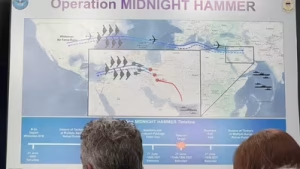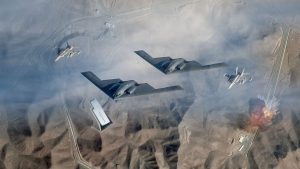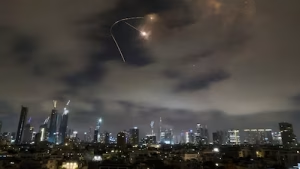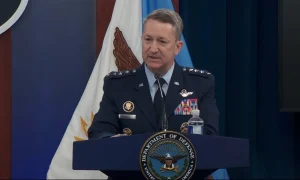Washington D.C. – The meticulously planned US Operation Midnight Hammer represents one of the most complex and successful military operations in recent American history. This comprehensive timeline reveals how the United States executed an 18-hour precision strike mission against Iranian nuclear facilities, demonstrating unprecedented military coordination and strategic planning.

Pre-Mission Planning and Strategic Coordination

The US Operation Midnight Hammer required months of careful preparation and intelligence gathering. Air Force General Dan Caine, Chairman of the Joint Chiefs of Staff, confirmed that only a select group of planners and key leaders in Washington and Tampa were aware of the operation’s details, emphasizing the extraordinary secrecy surrounding the mission.
The US Operation Midnight Hammer planning phase involved coordinating multiple military branches, including the Air Force, Navy, and various support commands. This integrated approach ensured that every aspect of the mission would execute with precision timing and maximum effectiveness against Iranian nuclear targets.
Strategic deception played a crucial role in the US Operation Midnight Hammer preparation. Military planners developed elaborate decoy operations to mislead Iranian intelligence services about the true nature and scope of the impending strikes.
June 21, 12:01 EDT – B-2 Bombers Depart Whiteman Air Force Base
The US Operation Midnight Hammer officially commenced when seven B-2 Spirit stealth bombers departed from Whiteman Air Force Base in Missouri. Each aircraft carried two crew members, representing the elite of American military aviation tasked with executing this critical mission.


The departure phase of US Operation Midnight Hammer involved sophisticated tactical deception. While the main strike force of B-2 bombers proceeded eastward toward their Iranian targets, a decoy package deliberately veered westward into the Pacific Ocean to confuse Iranian surveillance systems.
This initial phase of US Operation Midnight Hammer demonstrated the complexity of modern military operations, where psychological warfare and misdirection play crucial roles alongside conventional weapons systems. The successful deception allowed the main strike force to proceed undetected toward Iranian airspace.
Extended Flight Operations and Mid-Air Refueling
During the US Operation Midnight Hammer transit phase, the B-2 bombers conducted multiple in-flight refueling operations to maintain their range and operational capability. These refueling procedures required exact synchronization and minimal communications to preserve operational security.


The 18-hour duration of US Operation Midnight Hammer necessitated careful fuel management and crew endurance planning. B-2 stealth bombers are equipped with advanced crew facilities, including rest areas and basic amenities, enabling sustained long-range operations like this mission.
Air Force personnel executing US Operation Midnight Hammer maintained strict radio silence throughout most of the transit phase, relying on pre-planned coordinates and timing to ensure mission success without compromising their positions to Iranian defense systems.
June 21, 17:00 EDT – Strike Package Assembly
The US Operation Midnight Hammer reached a critical milestone when the B-2 bombers linked up with their escort and support aircraft within the Central Command Area of Responsibility. This complex aerial rendezvous required precise timing and coordination across multiple aircraft platforms.
Support aircraft joining US Operation Midnight Hammer included electronic warfare planes, aerial refueling tankers, and escort fighters designed to provide comprehensive protection for the strike package. The assembly occurred in tightly controlled airspace to minimize detection risks.
The successful coordination of US Operation Midnight Hammer support elements demonstrated American military logistics capabilities and the ability to project power across vast distances while maintaining operational surprise.
Maritime Launch Phase – Submarine Operations


Simultaneously with the aerial component, US Operation Midnight Hammer involved submarine-launched Tomahawk cruise missiles targeting critical infrastructure in Isfahan. This coordinated land-sea approach maximized the operation’s effectiveness and created multiple vectors of attack.
The submarine component of US Operation Midnight Hammer launched over two dozen Tomahawk missiles, providing additional firepower and ensuring comprehensive coverage of Iranian nuclear facilities. These precision-guided weapons complemented the bomber-delivered ordnance.
Naval forces participating in US Operation Midnight Hammer maintained complete stealth throughout their missile launch operations, successfully avoiding detection by Iranian naval or coastal defense systems.
June 21, 18:00 EDT – Penetration of Iranian Airspace
The most dangerous phase of US Operation Midnight Hammer began when the strike package entered Iranian airspace. Advanced electronic warfare capabilities and high-speed aircraft provided cover for the bomber formation as they approached their targets.

Iranian air defense systems failed to detect the US Operation Midnight Hammer strike package, highlighting the effectiveness of American stealth technology and electronic countermeasures. The B-2 bombers proceeded to their targets without encountering significant opposition.
Suppression of Enemy Air Defenses (SEAD) operations during US Operation Midnight Hammer involved deploying advanced weapons systems near Fordow and Natanz to neutralize potential threats to the strike aircraft.
June 21, 18:40-19:00 EDT – Target Engagement Phase
The culmination of US Operation Midnight Hammer occurred during the 20-minute target engagement window between 6:40 PM and 7:05 PM EDT. The lead B-2 bomber initiated strikes by dropping two GBU-57 Massive Ordnance Penetrators on the heavily fortified Fordow facility.
All three primary targets of US Operation Midnight Hammer – Fordow, Natanz, and Isfahan – received devastating strikes during this brief timeframe. The precision timing ensured maximum surprise and prevented Iranian forces from implementing defensive countermeasures.


The weapons deployment phase of US Operation Midnight Hammer demonstrated the destructive capability of modern American precision-guided munitions against hardened underground targets. The GBU-57 bombs proved particularly effective against Fordow’s mountain-buried facilities.
June 21, 19:30 EDT – Successful Withdrawal
Following weapons release, US Operation Midnight Hammer entered its withdrawal phase as the strike package exited Iranian airspace. No reports indicated any Iranian attempts to engage the departing American aircraft, suggesting complete tactical surprise was maintained throughout the operation.
The successful egress during US Operation Midnight Hammer confirmed the effectiveness of American stealth technology and operational planning. Iranian surface-to-air missile systems remained ineffective against the departing strike force.
June 22 – Mission Completion




The aftermath of Operation Midnight Hammer revealed the operation’s overwhelming success in degrading Iranian nuclear capabilities while maintaining zero American casualties. General Caine confirmed that the mission achieved all primary objectives.
Strategic Impact and Military Significance
Operation Midnight Hammer represents a watershed moment in American military operations, demonstrating the capability to conduct complex, long-range precision strikes against heavily defended targets. The 18-hour mission timeline showcases unprecedented coordination between air and naval forces.
The success of Operation Midnight Hammer sends a clear message about American military capabilities and resolve in preventing nuclear proliferation. This operation will likely influence future military planning and international diplomatic relationships in the Middle East region.

